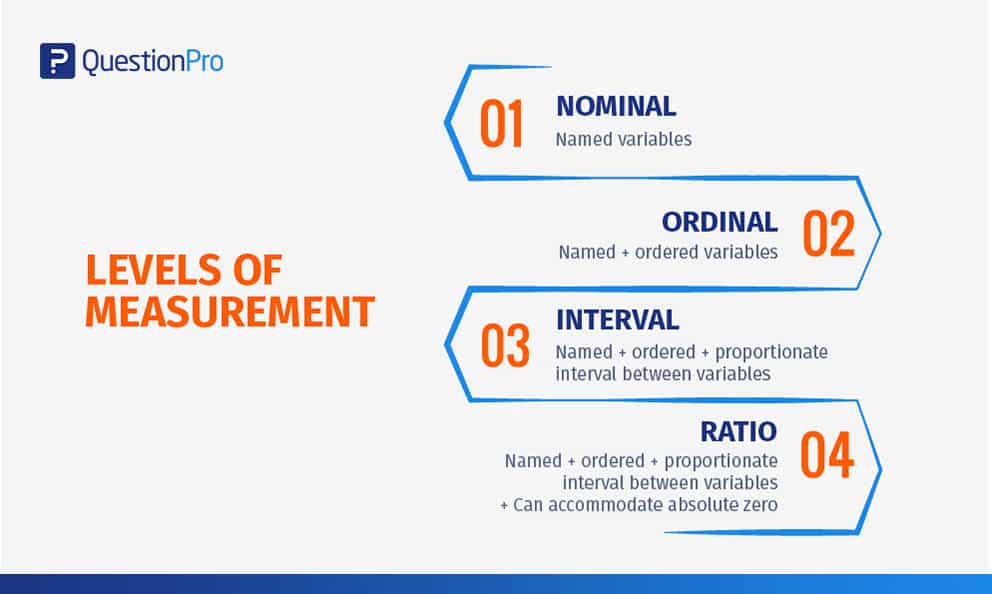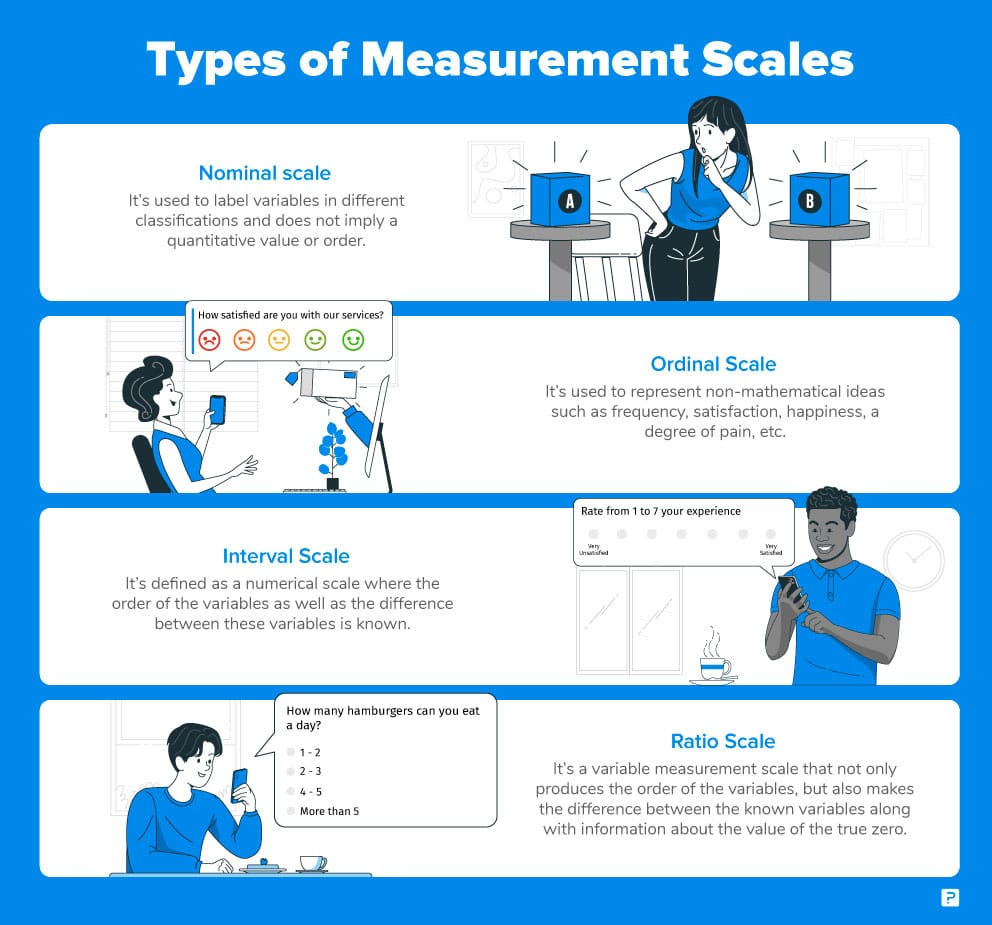
The nominal, ordinal, interval & ratio levels of measurement are scales that allow us to measure and classify gathered data in well-defined variables to be used for different purposes.
Mainly used for these four scales are:
- Nominal: Used to categorize data into mutually exclusive categories or groups.
- Ordinal: Used to measure variables in a natural order, such as rating or ranking. They provide meaningful insights into attitudes, preferences, and behaviors by understanding the order of responses.
- Interval: Used to measure variables with equal intervals between values. Temperature and time often make use of this type of measurement, enabling precise comparisons and calculations.
- Ratio: Allows for comparisons and computations such as ratios, percentages, and averages. Great for research in fields like science, engineering, and finance, where you need to use ratios, percentages, and averages to understand the data.
Below, we’ll discuss everything you need to know about these measurement levels, characteristics, examples, and how to use them.
Levels of Measurement in Statistics
To perform statistical data analysis, it is important first to understand variables and what should be measured using them.
There are different levels of measurement in statistics, and data measured using them can be broadly classified into qualitative and quantitative data. Let’s discuss the Nominal, Ordinal, Interval, and ratio scales.
First, let’s understand what a variable is. You can measure a variable, which is a quantity that changes across the population. For instance, consider a sample of employed individuals.
The variables for this set of the population can be industry, location, gender, age, skills, job type, paid time off, etc. The value of the variables will differ with each employee spotlight.
For example, it is practically impossible to calculate the average hourly rate of a worker in the US. So, a sample audience is randomly selected to represent the larger population appropriately.
Then, we calculate the average hourly rate of this sample audience. Using statistical tests, you can conclude the average hourly rate of a larger population. In statistical analysis, distinguishing between categorical data and numerical data is essential, as categorical data involves distinct categories or labels, while numerical data consists of measurable quantities.
A variable’s measurement level decides the statistical test type to be used. The mathematical nature of a variable, or in other words, how a variable is measured, is considered the level of measurement.
What are Nominal, Ordinal, Interval, and ratio?
Nominal, Ordinal, Interval, and ratio are defined as the four fundamental measurement scales used to capture data in the form of surveys and questionnaires, each being a multiple-choice question.
Each scale is an incremental level of measurement, meaning each scale fulfills the function of the previous scale, and all survey question scales, such as Likert, Semantic Differential, Dichotomous, etc, are the derivation of these four fundamental levels of variable measurement.
Before we discuss all four levels of measurement scales in detail, with examples, let’s briefly look at what these scales represent.
A nominal scale is a naming scale where variables are simply “named” or labeled with no specific order. The ordinal scale has all its variables in a specific order, beyond just naming them. Interval scale offers labels, order, as well as a specific interval between each of its variable options.
The ratio scale bears all the characteristics of an interval scale. In addition to that, it can also accommodate the value of “zero” on any of its variables.
Here’s more of the four levels of measurement in research and statistics: Nominal, Ordinal, Interval, Ratio.

LEARN ABOUT: Graphic Rating Scale
Nominal Scale: 1st Level of Measurement
Nominal Scale, also called the categorical variable scale, is defined as a scale that labels variables into distinct classifications and doesn’t involve a quantitative value or order. This scale is the simplest of the four variable measurement scales. Calculations done on these variables will be futile as the options have no numerical value.
There are cases where this scale is used for the purpose of classification – the numbers associated with variables of this scale are only tags for categorization or division. Calculations done on these numbers will be futile as they have no quantitative research significance.
For a question such as:
Where do you live?
- 1- Suburbs
- 2- City
- 3- Town
A nominal scale is often used in research surveys and questionnaires where only variable labels hold significance.
For instance, a customer survey asking “Which brand of smartphones do you prefer?” Options: “Apple”- 1, “Samsung”-2, “OnePlus”-3.
- In this survey question, only the names of the brands are significant for the researcher conducting consumer research or netnography. There is no need for any specific order for these brands. However, while capturing nominal data, researchers conduct analysis based on the associated labels.
- In the above example, when a survey respondent selects Apple as their preferred brand, the data entered and associated will be “1”. This helped in quantifying and answering the final question – How many respondents selected Apple, how many selected Samsung, and how many went for OnePlus – and which one is the highest?
- This is the fundamental of quantitative research, and the nominal scale is the most fundamental research scale.
Nominal Scale Data and Analysis
There are two primary ways in which nominal scale data can be collected:
- By asking an open-ended question, the answers of which can be coded to a respective number of labels decided by the researcher.
- The other alternative to collect nominal data is to include a multiple-choice question in which the answers will be labeled.
In both cases, the analysis of gathered data will happen using percentages or mode,i.e., the most common answer received for the question. It is possible for a single question to have more than one mode, as it is possible for two common favorites to exist in a target population.
Nominal Scale Examples
- Gender
- Political preferences
- Place of residence
| What is your Gender? | What is your Political preference? | Where do you live? |
|
|
|
LEARN ABOUT: Average Order Value
Nominal Scale SPSS
In SPSS, you can specify the level of measurement as scale (numeric data on an interval or ratio scale), ordinal, or nominal. Nominal and ordinal data can be either string alphanumeric or numeric.
Upon importing the data for any variable into the SPSS input file, it takes it as a scale variable by default since the data essentially contains numeric values. It is important to change it to either nominal or ordinal or keep it as scale depending on the variable the data represents.
Ordinal Scale: 2nd Level of Measurement
Ordinal Scale is defined as a variable measurement scale used to simply depict the order of variables and not the difference between each variable. These scales generally depict non-mathematical ideas such as frequency, satisfaction, happiness, a degree of pain, etc. It is quite straightforward to remember the implementation of this scale as ‘Ordinal’ sounds similar to ‘Order,’ which is exactly the purpose of this scale.
Ordinal Scale maintains descriptional qualities along with an intrinsic order but is void of an origin of scale, and thus, the distance between variables can’t be calculated. Descriptional qualities indicate tagging properties similar to the nominal scale, in addition to which the ordinal scale also has a relative position of variables. This scale’s origin is absent, so there is no fixed start or “true zero.”
Ordinal Data and Analysis
Ordinal scale data can be presented in tabular or graphical formats for a researcher to conduct a convenient analysis of collected data. Also, methods such as the Mann-Whitney U test and the Kruskal–Wallis H test can also be used to analyze ordinal data. These methods are generally implemented to compare two or more ordinal groups.
In the Mann-Whitney U test, researchers can conclude which variable of one group is bigger or smaller than another variable of a randomly selected group. In the Kruskal–Wallis H test, researchers can analyze whether two or more ordinal groups have the same median or not.
Ordinal Scale Examples
Status at the workplace, tournament team rankings, order of product quality, and order of agreement or satisfaction are some of the most common examples of the ordinal Scale. These scales are generally used in market research to gather and evaluate relative feedback about product satisfaction, changing perceptions with product upgrades, etc.
For example, a semantic differential scale question such as:
How satisfied are you with our services?
- Very Unsatisfied – 1
- Unsatisfied – 2
- Neutral – 3
- Satisfied – 4
- Very Satisfied – 5
- Here, the order of variables is of prime importance, and so is the labeling. Very unsatisfied will always be worse than unsatisfied, and satisfied will be worse than very satisfied.
- This is where the ordinal scale is a step above the nominal scale – the order is relevant to the results, and so is their naming.
- Analyzing results based on the order along with the name becomes a convenient process for the researcher.
- If they intend to obtain more information than what they would collect using a nominal scale, they can use the ordinal scale.
This scale not only assigns values to the variables but also measures the rank or order of the variables, such as:
- Grades
- Satisfaction
- Happiness
How satisfied are you with our services?
- 1- Very Unsatisfied
- 2- Unsatisfied
- 3- Neural
- 4- Satisfied
- 5- Very Satisfied
LEARN ABOUT: Nominal vs. Ordinal Scale
Interval Scale: 3rd Level of Measurement
Interval Scale is defined as a numerical scale where the variables’ order is known and the difference between these variables. Variables that have familiar, constant, and computable differences are classified using the Interval scale. It is easy to remember the primary role of this scale, too, ‘Interval’ indicates ‘distance between two entities,’ which is what the Interval scale helps achieve.
These scales are effective as they open doors for the statistical analysis of provided data. Mean, median, or mode can be used to calculate the central tendency in this scale. The only drawback of this scale is that there is no pre-decided starting point or a true zero value.
The interval scale contains all the properties of the ordinal scale and offers a calculation of the difference between variables. The main characteristic of this scale is the equidistant difference between objects.
For instance, consider a Celsius/Fahrenheit temperature scale –
- Eighty degrees is always higher than 50 degrees, and the difference between these two temperatures is the same as the difference between 70 degrees and 40 degrees.
- Also, the value of 0 is arbitrary because negative temperature values exist – which makes the Celsius/Fahrenheit temperature scale a classic example of an interval scale.
- Interval scale is often chosen in research cases where the difference between variables is a mandate – which can’t be achieved using a nominal or ordinal scale. The Interval scale quantifies the difference between two variables, whereas the other two scales can solely associate qualitative observation values with variables.
- Unlike the previous two scales, an ordinal scale’s mean and median values can be evaluated.
- In statistics, interval scale is frequently used as a numerical value that can not only be assigned to variables but calculations based on those values can also be carried out.
Even if interval scales are amazing, they do not calculate the “true zero” value, which is why the next scale comes into the picture.
Interval Data and Analysis
All the techniques applicable to nominal and ordinal data analysis are applicable to Interval Data as well. Apart from those techniques, there are a few analysis methods, such as descriptive statistics correlation regression analysis, which is extensively used for analyzing interval data.
Descriptive analysis statistics is the term given to the analysis of numerical data. It helps to describe, depict, or summarize data in a meaningful manner, and it helps in the calculation of mean, median, and mode.
LEARN MORE: Descriptive Research vs Correlational Research
Interval Scale Examples
- There are situations where attitude scales are considered to be interval scales.
- Apart from the temperature scale, time is also a very common example of an interval scale, as the values are already established, constant, and measurable.
- Calendar years and times also fall under this category of measurement scales.
- Likert scale, Net Promoter Score, Semantic Differential Scale, Bipolar Matrix Table, etc., are the most-used interval scale examples.
The following questions fall under the Interval Scale category:
- What is your family income?
- What is the temperature in your city?
Ratio Scale: 4th Level of Measurement
Ratio Scale is defined as a variable measurement scale that not only produces the order of variables but also makes the difference between variables known, along with information on the value of true zero. It is calculated by assuming that the variables have an option for zero, the difference between the two variables is the same, and there is a specific order between the options.
With the option of true zero, varied inferential statistics and descriptive analysis techniques can be applied to the variables. In addition to the fact that the ratio scale does everything that a nominal, ordinal, and interval scale can do, it can also establish the value of absolute zero. The best examples of ratio scales are weight and height. In market research, a ratio scale is used to calculate market share, annual sales, the price of an upcoming product, the number of consumers, etc.
- The ratio scale provides the most detailed information as researchers and statisticians can calculate the central tendency using statistical techniques such as mean, median, and mode, and methods such as geometric mean, coefficient of variation, or harmonic mean can also be used on this scale.
- The ratio scale accommodates the characteristics of three other variable measurement scales, i.e., labeling the variables, the significance of the order of variables, and a calculable difference between variables (which are usually equidistant).
- Because of the existence of a true zero value, the ratio scale doesn’t have negative values.
- To decide when to use a ratio scale, the researcher must observe whether the variables have all the characteristics of an interval scale along with the presence of the absolute zero value.
- The ratio scale can calculate the mean, mode, and median.
Ratio Data and Analysis
At a fundamental level, Ratio scale data is quantitative in nature, due to which all quantitative analysis techniques, such as SWOT, TURF, Cross-tabulation, Conjoint, etc., can be used to calculate ratio data. While some techniques, such as SWOT and TURF, will analyze ratio data in such a manner that researchers can create roadmaps of how to improve products or services and Cross-tabulation will be useful in understanding whether new features will be helpful to the target market or not.
LEARN ABOUT: Level of Analysis
Ratio Scale Examples
The following questions fall under the Ratio Scale category:
- What is your daughter’s current height?
- Less than 5 feet.
- 5 feet 1 inch – 5 feet 5 inches
- 5 feet 6 inches- 6 feet
- More than 6 feet
- What is your weight in kilograms?
- Less than 50 kilograms
- 51- 70 kilograms
- 71- 90 kilograms
- 91-110 kilograms
- More than 110 kilograms
Nominal, Ordinal, Interval, Ratio: Main Characteristics
The four data measurement scales – nominal, ordinal, interval, and ratio – are quite often discussed in academic teaching. The easy-to-remember chart might help you in your statistics test.
| Offers: | Nominal | Ordinal | Interval | Ratio |
| The sequence of variables is established | – | Yes | Yes | Yes |
| Mode | Yes | Yes | Yes | Yes |
| Median | – | Yes | Yes | Yes |
| Mean | – | – | Yes | Yes |
| Difference between variables can be evaluated | – | – | Yes | Yes |
| Addition and Subtraction of variables | – | – | Yes | Yes |
| Multiplication and Division of variables | – | – | – | Yes |
| Absolute zero | – | – | – | Yes |
LEARN ABOUT: Interval vs. Ratio Scale & Population vs Sample
Conclusion
Understanding the levels of measurement is crucial in research, as it affects the type of analysis that can be performed and the conclusions that can be drawn from the data. By understanding the differences between nominal, ordinal, interval, and ratio data, researchers can make more informed decisions about the appropriate statistical tests to use and how to interpret their results.
Remember that selecting the appropriate level of measurement is a critical step in designing a research study, so take the time to carefully consider the measurement level most appropriate for your research question and data.
QuestionPro offers various types of questions that will allow you to collect data for any variable, as well as powerful data analysis tools and data management platforms to harness the full potential of your studies.
Frequently Asked Questions (FAQs)
The four levels of measurement are:
Nominal Level: This is the most basic level of measurement, where data is categorized without any quantitative value.
Ordinal Level: In this level, data can be categorized and ranked in a meaningful order, but the intervals between the ranks are not necessarily equal.
Interval Level: This level involves numerical data where the intervals between values are meaningful and equal, but there is no true zero point.
Ratio Level: This is the highest level of measurement, where data can be categorized, ranked, and the intervals are equal, with a true zero point that indicates the absence of the quantity being measured.
The four types of measurement scales are:
Nominal: Categorical data without any order (e.g., gender, colors).
Ordinal: Categorical data with a meaningful order but no equal intervals (e.g., satisfaction ratings).
Interval: Numeric data with equal intervals but no true zero (e.g., temperature in Celsius).
Ratio: Numeric data with equal intervals and a true zero (e.g., weight, height).
Example of Ratio:
Weight: A weight of 0 kg indicates no weight, and you can compare weights (e.g., 10 kg is twice as heavy as 5 kg).
Example of Interval:
Temperature (Celsius): The temperature of 0°C does not mean there is no temperature; it’s just a point on the scale. The difference between 10°C and 20°C is the same as between 20°C and 30°C, but you cannot say that 20°C is twice as hot as 10°C.
Here are examples of both nominal and ordinal data:
Nominal Data:
Example: Types of fruit (e.g., apples, bananas, oranges)
Explanation: Nominal data is categorical and does not have a specific order. Each category is distinct and cannot be ranked.
Ordinal Data:
Example: Customer satisfaction ratings (e.g., poor, fair, good, excellent)
Explanation: Ordinal data has a clear order or ranking. The categories indicate a level of satisfaction, but the intervals between the categories are not necessarily equal.







